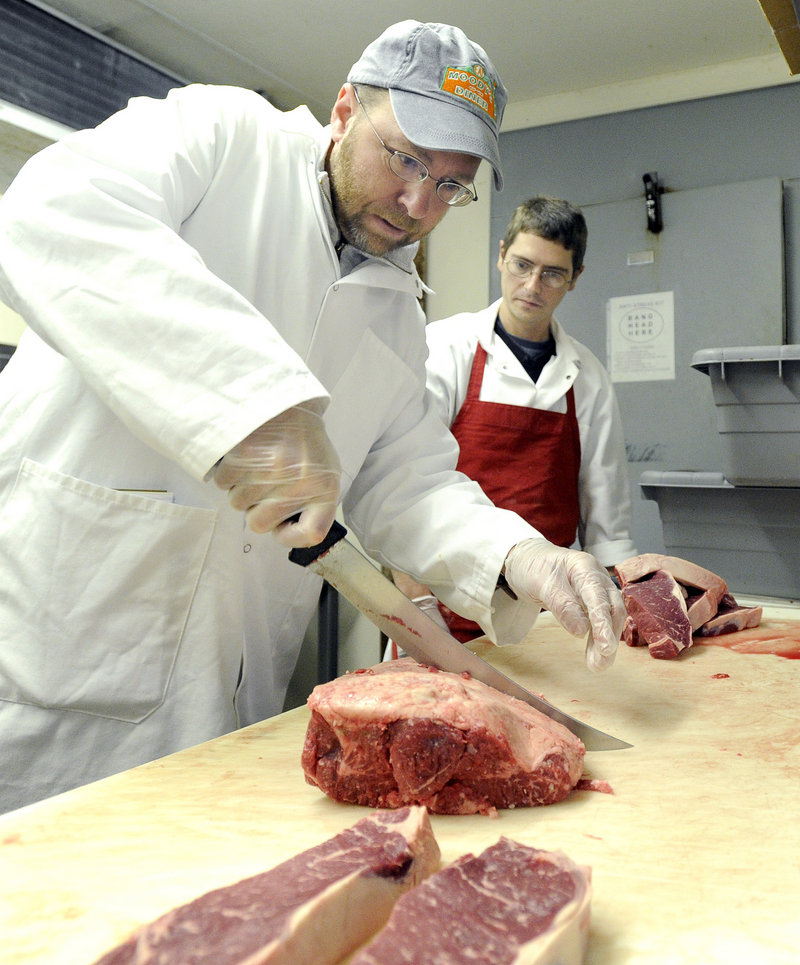PORTLAND – After I’d spent a few minutes chopping up 100 pounds of pork butt for sausage, the fingers on my left hand were freezing. Holding the cold pork to cut it made me feel like I had been throwing snowballs without gloves.
I mentioned it to Chris McCourt, meat manager at the Fresh Approach Market in Portland’s West End, who was working a few feet away.
“Oh, you’ll get used to that,” said McCourt, 33, of Windham.
“Really? That’s good to know,” I said.
“Actually, that’s a little meat room joke. You never get used to it,” McCourt said.
Other than that brief interlude of levity, McCourt was all business as he showed me the ropes of cutting meat at his family’s market. The market has been owned for 18 years by his stepfather, Chet Knights. McCourt literally grew up in the business, learning to cut meat at a professional level when he was about 13.
“I can show anybody how to cut meat, but to make money it’s all about the merchandising, making it look good,” said Knights, himself a meat cutter. “Chris is one who can make money at it.”
McCourt told me early on that there are times when he will “cut” the meat, so that it can be presented pleasingly in the meat case. Other times, if the meat is being used for something else, he can just “hack.”
We started the morning cutting some New York strip steaks, which would sell for $9.99 a pound. McCourt put the hunk of meat on the cutting table and handed me a knife — it looked more like a machete to me. It was about 2 feet long, with a curved blade.
McCourt told me to apply pressure with the front of the knife first, then the back. When he cut the steaks, he looked like he was slicing soft butter. When I tried, I just sort of made a tear in the top of the steak. I had to use two hands to get through some of the pieces.
“Yeah, it takes a little practice,” McCourt told me.
Then I trimmed some of the fat off the steaks using a much smaller knife. For safety reasons, McCourt said, it’s important not to trim with the big knife.
Once, he was trimming with the big knife, and when he flipped a piece of meat over, he pierced his hand and needed stitches.
One of the only other times he has cut himself in a serious way was when he knocked the big knife off the table and reached to grab it while it was falling.
The knives McCourt uses are incredibly sharp. He rents four sets each week from a company in Boston.
“If you knock a knife off, just let it fall,” he said.
I had seen McCourt cut a 3-foot-long pork loin a few minutes earlier with a meat band saw. The machine roared and the blade pulsed just like a band saw in a woodworking shop. I asked McCourt if he had been hurt by that saw.
“No. If you cut yourself with that, you lose a finger,” said McCourt.
While McCourt trimmed the fat off the strip steak, I watched him leave about an eighth of an inch of the fat. He does that, he said, because “the fat has the flavor.” So I asked why he didn’t leave more. He said because fat has fallen out of favor, even with meat eaters.
“Ten or 20 years ago, you could leave twice as much, but people just don’t want it,” McCourt said.
After McCourt had cut some pieces of pork loin off with the meat band saw, he let me try but cautioned me to be very careful. The pulsing blade made me nervous, and I wasn’t able to grip the loin tightly enough or close enough to the blade to get a real clean cut. So I handed the loin back to McCourt.
After he had cut the loin pieces, he showed me where the blade had left “bone dust” on the pieces. So he gave me a little plastic gizmo — a pork scraper, he called it — and directed me to scrape the bone dust off. Bone goes bad before meat, so he doesn’t leave that dust there, he told me.
When it was time to make sausage — Fresh Approach makes about 30 kinds — McCourt gave me 100 pounds of giant pork shoulders — pork butt — and told me I could just “hack.”
I needed pieces that could be fed easily into a 6- or 8-inch-round grinding machine hole, but the pieces didn’t have to be pretty.
I found pork to be easier to cut than beef, so the hacking was no problem — except for freezing fingers. Many meat cutters get tendonitis and related ailments because of the constant repetition of the cutting motion, McCourt told me.
The grinding was easy. McCourt said the only thing to be careful about was not to let my hand slip down the hole. So I didn’t.
After grinding, we had big pans full of meat, ready for seasoning. McCourt poured in water and the secret spice mix, and told me to mix, with my hands. (I was wearing rubber gloves the whole time.)
So I dug in and started mixing. Within minutes, my hands were freezing again.
I also began to notice that working with meat all morning had left my coat well spattered, as well as my notebook and my pen.
“Yeah, it can get pretty messy,” said McCourt. “When I go home, I leave my boots here.”
Staff Writer Ray Routhier can be contacted at 791-6454 or at:
rrouthier@pressherald.com
Send questions/comments to the editors.



